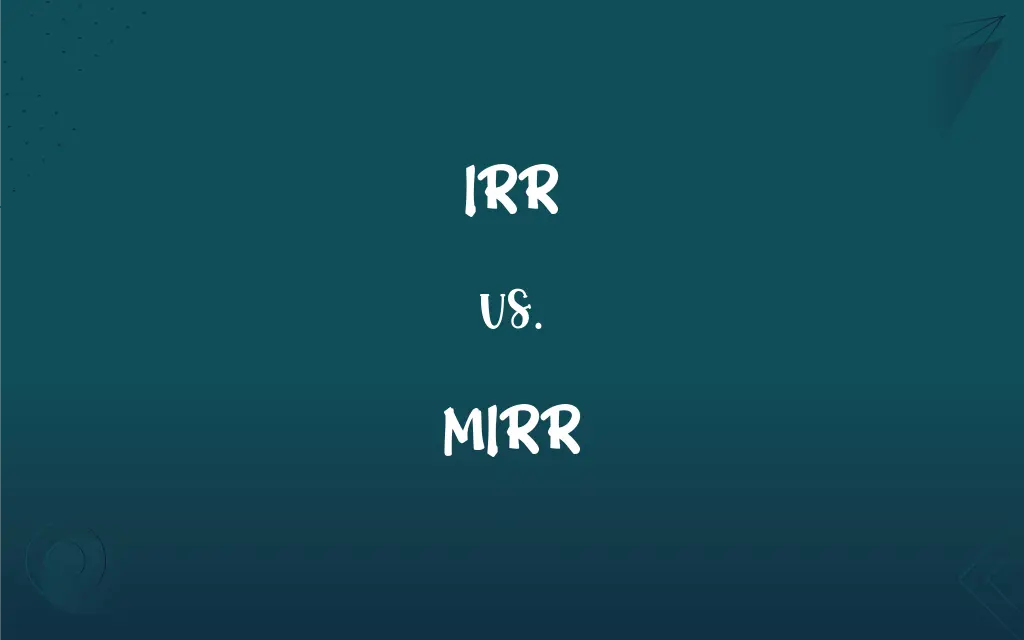IRR vs. MIRR: What's the Difference?
Edited by Aimie Carlson || By Harlon Moss || Updated on October 16, 2023
IRR (Internal Rate of Return) is the discount rate that makes NPV (Net Present Value) of a project zero, while MIRR (Modified Internal Rate of Return) adjusts IRR to account for varying reinvestment rates.

Key Differences
IRR, or the Internal Rate of Return, is a financial metric commonly used to evaluate the attractiveness of an investment or project. It represents the discount rate that equates the present value of an investment's expected future cash flows to its initial cost. When the IRR is greater than the cost of capital, the investment is typically considered favorable.
MIRR, on the other hand, stands for Modified Internal Rate of Return. While IRR assumes that cash inflows from an investment are reinvested at the IRR itself, MIRR modifies this assumption. MIRR takes into account a separate reinvestment rate and a financing rate, providing a more realistic reflection of an investment's potential returns.
One significant drawback of IRR is that it can sometimes give multiple values if there are alternating positive and negative cash flows. This can be confusing for investors trying to determine the true profitability of a project. MIRR addresses this issue by providing a single, unique solution for any set of cash flows.
Another difference between IRR and MIRR is in their sensitivity to the reinvestment rate. While IRR assumes that interim cash flows are reinvested at the IRR itself, this might not be practical in real-world scenarios. MIRR, by accounting for a different reinvestment rate, offers a more nuanced and arguably more accurate reflection of an investment's profitability.
Comparison Chart
Definition
Discount rate making NPV of a project zero.
Adjusts IRR for varying reinvestment rates.
ADVERTISEMENT
Assumption
Reinvests at IRR itself.
Uses separate reinvestment and financing rates.
Values
Can have multiple values for certain cash flows
Always provides a unique solution.
Sensitivity
Highly sensitive to cash flow patterns.
Less sensitive due to realistic assumptions.
Real-world Application
Might be overly optimistic in some cases.
Provides a more realistic profitability measure.
IRR and MIRR Definitions
IRR
IRR equates the present value of cash inflows to outflows.
If the IRR is 10%, the project breaks even at a 10% discount rate.
ADVERTISEMENT
MIRR
MIRR typically provides a single solution for returns.
Even with alternating cash flows, MIRR gave us a unique value.
IRR
A higher IRR indicates a more desirable investment.
A project with a 15% IRR is more appealing than one with a 10% IRR.
MIRR
MIRR factors in financing and reinvestment rates.
The project's MIRR was calculated using a 5% financing rate.
IRR
IRR stands for Internal Rate of Return.
The project's IRR exceeded our expectations.
MIRR
MIRR stands for Modified Internal Rate of Return.
The company prefers using MIRR over IRR for evaluations.
IRR
IRR is a financial metric used in capital budgeting.
We use IRR to evaluate potential projects.
MIRR
MIRR addresses the limitations of the traditional IRR.
By considering external reinvestment rates, MIRR eliminates IRR's multiple value issue.
IRR
IRR can sometimes offer multiple solutions.
Due to mixed cash flows, the project had two IRR values.
MIRR
MIRR offers a more realistic return measurement.
MIRR factors in the project's reinvestment rate.
FAQs
How is IRR calculated?
IRR is the discount rate that makes the NPV of a project zero.
What does a higher IRR signify?
A higher IRR indicates a potentially more profitable investment.
What does IRR stand for?
IRR stands for Internal Rate of Return.
Is MIRR considered more realistic than IRR?
Yes, because MIRR considers a separate reinvestment rate, making it more realistic.
Which metric is more sensitive to cash flow patterns?
IRR is more sensitive due to its assumptions.
Why might IRR be deemed overly optimistic?
IRR might be overly optimistic as it assumes reinvestment at the IRR itself.
What does MIRR stand for?
MIRR stands for Modified Internal Rate of Return.
Can MIRR provide multiple values like IRR?
No, MIRR always provides a single solution for any set of cash flows.
Do both IRR and MIRR require an initial investment value?
Yes, both metrics evaluate returns relative to an initial investment.
What is the primary advantage of using MIRR?
MIRR offers a more accurate reflection of an investment's potential returns.
What's the main limitation of IRR?
IRR assumes cash flows are reinvested at the IRR itself, which might not always be accurate.
Can MIRR be used for projects with mixed cash flows?
Yes, MIRR can handle projects with mixed cash flows and provide a unique solution.
Is MIRR always higher or lower than IRR?
Not necessarily; MIRR's value depends on the reinvestment and financing rates used.
How does MIRR account for the cost of capital?
MIRR considers both financing and reinvestment rates, offering a comprehensive view.
Can both metrics be used for non-financial evaluations?
While primarily financial metrics, they can be adapted for non-financial evaluations with careful consideration.
Which is more widely used in the industry: IRR or MIRR?
IRR is more commonly used, but MIRR is gaining traction due to its realistic assumptions.
Is it advisable to rely solely on IRR or MIRR for investment decisions?
While useful, it's best to use them in conjunction with other financial metrics for a holistic view.
Can IRR have multiple values?
Yes, IRR can sometimes give multiple values for alternating cash flows.
How does MIRR differ from IRR?
MIRR adjusts the IRR to account for different reinvestment rates.
Why might companies prefer MIRR over IRR?
MIRR addresses IRR's limitations and provides a clearer profitability measure.
About Author
Written by
Harlon MossHarlon is a seasoned quality moderator and accomplished content writer for Difference Wiki. An alumnus of the prestigious University of California, he earned his degree in Computer Science. Leveraging his academic background, Harlon brings a meticulous and informed perspective to his work, ensuring content accuracy and excellence.
Edited by
Aimie CarlsonAimie Carlson, holding a master's degree in English literature, is a fervent English language enthusiast. She lends her writing talents to Difference Wiki, a prominent website that specializes in comparisons, offering readers insightful analyses that both captivate and inform.






























































